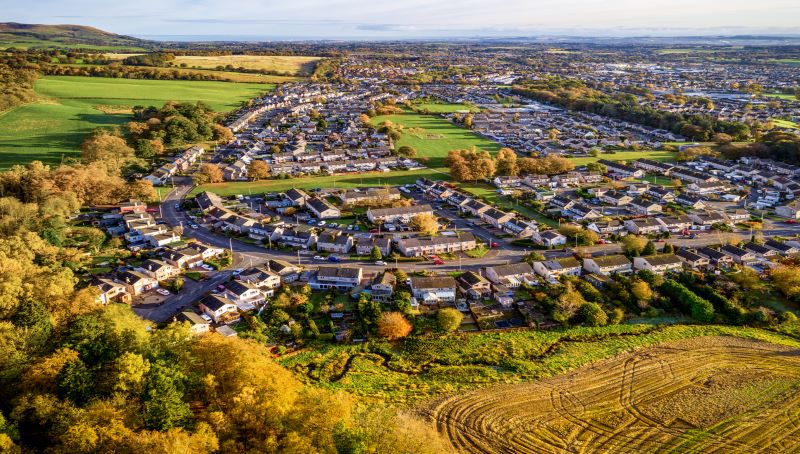
The Government has confirmed it is putting “beauty” at the heart of the planning system, as well as making processes more digital.
Unveiled by Housing Secretary Robert Jenrick, “the Building Beautiful Places plan will mean good quality design will be paramount, with local communities put at the very heart of decision-making to help shape their towns and cities.”
The National Planning Policy Framework is being amended (NPPF) so that the Building Beautiful Places plan will mean “residents and planners will find it easier to embrace beautiful, practical design while rejecting the ugly, unsustainable or poor quality,” MHCLG say.
The changes “set an expectation” that all councils should develop a local design code and demonstrate how to involve local communities in that design code.
Among the measures are:
- The National Model Design Code – a toolkit to enable every council and community to create their own local design requirement. Guidance is provided across all aspects of new development including tree-lined streets, sustainable drainage and design to support walking and cycling.
- Updated planning framework published which will place greater emphasis on beauty, place-making, the environment, sustainable development and underlines the importance of local design codes.
- The Office for Place which will drive up design standards, testing and piloting the National Model Design Code with more than 20 local councils and communities.
- The Advisory Board, made up of industry experts and chaired by Nicholas Boys Smith, which will advise on the work of the Office for Place and options for a potential independent body.
Housing Secretary, Robert Jenrick, said: “Today I have set out the Government’s vision for a planning system that make beautiful, sustainable and life-enhancing design a necessity, rather than a luxury.
“Our revised National Planning Policy Framework will ensure that communities are more meaningfully engaged in how new development happens, that local authorities are given greater confidence in turning down schemes which do not meet locally set standards.
“This is about putting communities – not developers – in the driving seat to ensure good quality design is the norm, and the return to a sense of stewardship – to building greener, enduringly popular homes and places that stand the test of time in every sense.
Nicholas Boys Smith, Chair of the Advisory Board for the Office for Place, said: “I am delighted to be chairing the new Office for Place. Britain has created and is creating some of the best developments in the world. But the quality achieved remains stubbornly inconsistent.
“We must do better, more often for the benefit of communities, to contribute to the economic success of our towns and cities and to look after our planet.
“Our vision is to help families, neighbourhoods, councils, landowners, housebuilders and developers more easily create places in which our communities can prosper.
“The Office for Place aims to encourage the British design and development industries to be the best ‘place-makers’ in the world aided by improving data on the discoverable links between place with happiness, health, popularity and sustainability.”
Paul Miner, head of land use and planning at CPRE, the countryside charity, said: “Good design is crucial for healthy, thriving and low carbon communities in our countryside. That’s why it is hugely welcome to see these new design codes and the launch of the new Office for Place.
“We must turn the tide on the decades of disastrous design. Over three quarters of large housing developments scored mediocre or poor on our 2020 housing design audit with University College London.
“Too many of these are car dependent developments in the middle of nowhere. We’re urging the Office for Place to make reliable public transport and active travel central in creating the communities of the future.’
“But the government’s disastrous planning proposals, that look set to halve democratic input in planning, will completely undermine any progress on design and design codes.
“Good design is impossible without local democracy and accountability in the planning system. So, if Ministers are serious about creating the beautiful places of the future, they should start by totally rethinking their planning proposals and ensure people and nature are put back at the heart of planning.”
Cllr David Renard, Housing Spokesperson for the Local Government Association, said: “Councils have constantly delivered throughout the pandemic and are key to helping the Government build back locally as we all recover from it.
“This includes delivering the high-quality affordable housing we desperately need, built in the right places and supported by the right infrastructure. We also support innovative design to achieve climate-friendly homes and to improve the quality of homes and places.
“Design tools can be helpful, but decisions about the design of planning need to be locally-led and are best made by local councils together with their communities. As the Government’s National Design Guide advises, any specific details and measurable criteria for good design is most appropriately set out at a local level. The requirement for councils to have a local design code will also require additional resources and skills, so it will be important that councils are fully funded and supported to provide the extra capacity needed.
“We would also like to see the Office for Place body include local government representation, so it can benefit from the expertise and knowledge from a local level.”





